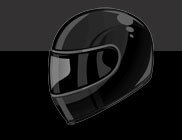Motorcycle Sunglasses Lenses Options
The first thing to check for are optically correct motorcycle sunglasses lenses.
A cheaply made lens with have imperfections that will slightly distort an
object. If the edge is distorted or curves as you move the glasses then you will
have to continually refocus and this causes severe eye strain which will reduce
the enjoyment of your ride. If your helmet's visor is less than perfect poor
lenses will only magnify the problem.
All of the motorcycle sunglasses
lenses that I recommend have optically correct lenses.
Lens Materials
Glass is the most optically correct, but for riding, a plastic lens is usually the best choice. Here's why:
- Quality glass lenses offer the best viewing quality
and are the most scratch-resistant. BUT, they will be heavier, cost more money and
are more prone to shatter when hit.
- CR-39 Plastic is thinner and weighs half
as much as glass It exceeds the FDA requirements for impact-resistance.
- Polycarbonate Plastic is a remarkably strong plastic, it
weighs the least and is the most impact-resistant making it a perfect choice
for motorcycle sunglasses lenses especially if you don't use a faceshield on
your helmet. They also offer built-in ultraviolet protection. This is my
choice for motorcycle sunglasses lenses.
- Acrylic Plastic will weigh less and are the least
expensive. They are soft and will scratch very easily. Must be specially
treated to block UV. Not the best choice for motorcycle sunglasses lenses.
Lens Tints or Colors
The darker the tint of your motorcycle sunglasses lenses, the more light it
absorbs. This choice is largely what you like best, but different colors do have
different uses.
- Amber, Orange or Copper Reduces blue light (a chief
component of glare), increases contrast, brightens and enhances detail. I
like this color for my cage driving glasses.
- Brown Cuts glare, works well in variable light conditions
and allows excellent contrast. It's dark color minimizes eye strain.
- Gray Neutral shade that keeps color distortion to a
minimum and will let you see most naturally while also reducing glare. This
is a great choice for motorcycle sunglasses.
- Green Enhances contrast in low light conditions and will
reduce eyestrain in bright light conditions for greatest visual detail. Best
general all purpose lens.
- Rose Offers high contrast and is very soothing to the
eyes while providing excellent light and glare protection. Works well in all
daytime light conditions. This is John
Conlee's favorite. ;-)
- Vermilion Used to contrast objects against blue and
green, they provide excellent perception in the low light conditions of an
overcast day while offering acceptable protection in bright sunlight. Good
color for driving or motorcycling.
- Yellow Provides depth perception and
visual contrast in low light conditions. Ideal for night riding, overcast,
haze or fog conditions.
Coatings
The darker the original tint, the more light it absorbs.
- Anti-reflective Consist of several layers of metal oxides
applied to the front and back lens surface. Because of the layering effect,
AR coatings sometimes have a hint of green or purple color, depending on the
individual manufacturers process. Each layer is calculated to block
reflected light resulting in a reduction in glare, annoying reflections and
halos around light sources.
- Gradient Permanently shaded from top to bottom. A
double-gradient lens is dark at the top & bottom and lighter in the middle.
Most often found in driving and flying lenses so that the dashboard and
instrument panels are seen clearly.
- Mirror or Flash Highly reflective and greatly reduces the
amount of light that reaches your eyes. Generally applied over a dark
sunglasses lens, but can be applied over any base color. Mirror coated
lenses absorb anywhere from 10% to 60% more light than uncoated lenses.
These are very popular and now come in a variety of colors in addition to
the classic silver (chrome) color.
- Photochromic Will automatically darken and lighten when
the light changes, although the cheaper photochromic lenses won't get very
dark and take some time to adjust to different conditions. Will require
conditioning the lens first through several exposures to the sun in order to
darken fully.
- Polarized A filter sandwiched between the front and back
surface of the lens which filters out horizontally reflected glare and
allows you to see through glare on the surface of water, snow, ice, glass
etc. Ideal if you're lucky enought to ride beside water regularly. Absorbs
98% of the reflected glare.
- Scratch-Resistant No lens material is scratch-proof,
although a lens that is treated front and back with a clear, hard coating
does become more resistant to scratches. Most types of plastic lenses have
built-in scratch-resistant coatings.
- Ultraviolet Treatment Blocks the sun's harmful UV rays
from damaging your eyes. Overexposure to ultraviolet light is thought to be
a cause of cataracts, retinal damage and other eye problems.
Shop for the best motorcycle sunglasses
|


